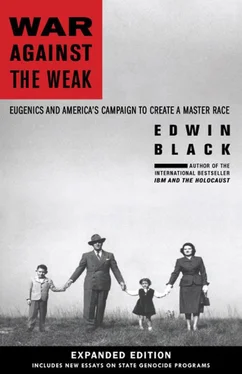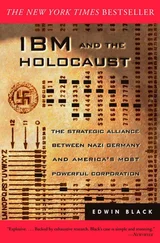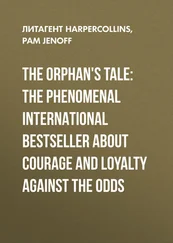Edwin Black - War Against the Weak
Здесь есть возможность читать онлайн «Edwin Black - War Against the Weak» весь текст электронной книги совершенно бесплатно (целиком полную версию без сокращений). В некоторых случаях можно слушать аудио, скачать через торрент в формате fb2 и присутствует краткое содержание. Город: Washington, DC, Год выпуска: 2012, ISBN: 2012, Издательство: Dialog Press, Жанр: История, на английском языке. Описание произведения, (предисловие) а так же отзывы посетителей доступны на портале библиотеки ЛибКат.
- Название:War Against the Weak
- Автор:
- Издательство:Dialog Press
- Жанр:
- Год:2012
- Город:Washington, DC
- ISBN:1-56858-258-7
- Рейтинг книги:3 / 5. Голосов: 2
-
Избранное:Добавить в избранное
- Отзывы:
-
Ваша оценка:
- 60
- 1
- 2
- 3
- 4
- 5
War Against the Weak: краткое содержание, описание и аннотация
Предлагаем к чтению аннотацию, описание, краткое содержание или предисловие (зависит от того, что написал сам автор книги «War Against the Weak»). Если вы не нашли необходимую информацию о книге — напишите в комментариях, мы постараемся отыскать её.
War Against the Weak — читать онлайн бесплатно полную книгу (весь текст) целиком
Ниже представлен текст книги, разбитый по страницам. Система сохранения места последней прочитанной страницы, позволяет с удобством читать онлайн бесплатно книгу «War Against the Weak», без необходимости каждый раз заново искать на чём Вы остановились. Поставьте закладку, и сможете в любой момент перейти на страницу, на которой закончили чтение.
Интервал:
Закладка:
Eugenic rallying calls were heard everywhere in Connecticut’s social worker elite. In 1910, Edwin A. Down, in his capacity as president of the Connecticut State Board of Charities, announced at the first annual state Conference of Charities and Corrections that the kindest “act of charity” society could show to an economically disadvantaged or “degenerate” person was to sterilize the individual. In 1934, Connecticut Congregationalist Pastor George Reid Andrews walked away from his pulpit to assume the AES presidency, averring he could save more people through eugenics, which had become his de facto religion. Pioneer German eugenicist Alfred Ploetz, the man who literally founded the concept of rassenhygeine , that is, Nazi eugenics, first studied racial genealogy in Meridian, Connecticut, before bringing his rabid ideology back to Germany and the Nazi Party.
Charles Davenport, the father of organized American eugenics and the movement’s scientific guru, was a Connecticut native. Davenport developed his earliest notions in the state’s intellectual and medical circles, constantly churning with eugenic fascination. Davenport went on to organize the triad of raceology agencies at Cold Spring Harbor sponsored by the Carnegie Institution. The three entities included the Station for Experimental Biology, the Eugenics Research Association, and the Eugenics Record Office. At Cold Spring Harbor, Davenport mentored his henchman Harry Laughlin, who functioned as superintendent of the Eugenics Record Office, the nerve center crammed with dark brown floor-to-ceiling card files. Within those long drawers were collected endless personal records, from family trees to idle gossip. It was all assembled in a delusional attempt to create authentic family pedigrees that could be judged worthy or unworthy of continued existence on earth.
Congress had christened Laughlin a “federal eugenics agent” during immigration control hearings that helped establish the 1924 National Origins Act. As a consequence, Laughlin designed the ethnic and genetic formulas that eventually evolved into the Third Reich’s 1935 Nuremberg Race Laws. In 1937, he received an honorary Nazi degree from the University of Heidelberg for his contribution to Hitler’s war against the Jews. It was this man, haloed as a Carnegie Institution researcher, who almost single-handedly transformed Connecticut into a mini-Nazi eugenic state. Laughlin’s program came complete with concentration camps, de-citizenship laws, and a mass killing program designed to ethnically cleanse vast numbers of Americans.
The state’s walk toward Nazism began in late 1936, when Connecticut governor Wilbur Cross commissioned Laughlin as a Carnegie expert to undertake a “Survey of the Human Resources of Connecticut.” The purpose of the survey was to bring Nazi-style ethnic cleansing to Connecticut in an organized scientific fashion but devoid of the type of Brownshirt violence that so typified Nazi Germany. Obviously, Laughlin was the perfect choice. He was editor of Eugenical News , a leader of the AES, and America’s most accomplished authority on preparing government-backed elimination of unfit families.
Connecticut’s official report called upon the state’s 2,400 physicians to assume personal responsibility for “selection of an individual for sterilization under the state’s statutes, which govern this means of preventing future degeneracy… Thus when in social medicine the physician works for the elimination of human defect, he performs an invaluable service.” These ideas were incorporated into a formal public address that was presented to the Yale Medical School by the eugenic commission’s chairman, former Connecticut senator Frederick C. Walcott.
Connecticut officials placed much of their hopes on “physicians who specialize in diseases of the eye, the ear, on nervous or mental disorders, on the heart, the lungs, the digestive system, and upon crippled bodies.” The plan was to eliminate the family bloodlines of anyone who was sick. Indeed, special emphasis was placed on those with even the slightest vision problems. In that regard, the nation’s organized ophthalmologists had long promoted legislation to identify all those related to anyone with a vision problem so they could be rounded up, placed in camps, and their marriages prohibited or annulled. Ultimately, had the ophthalmologists been successful, anyone related to anyone with a vision problem would have been forcibly sterilized.
Connecticut’s survey of humans was to parallel similar biological surveys of “useful plant and animal life,” as its preamble makes clear. “Human weeds,” a term popularized by eugenicist Margaret Sanger, were to be eradicated as diligently as garden weeds. Indeed, because eugenicists saw themselves as breeders and were encouraged by the US Department of Agriculture, they considered the human species as one to be pruned and cultivated, like any herd of cattle or field of corn. Eugenicists believed that crime, poverty, immorality, unchaste behavior, and other undesired traits were genetic and could not be stamped out unless the entire family was prevented from reproducing or otherwise eliminated from nature.
Laughlin was a stickler for minute details, which he generally organized with excruciating specificity. His ethnic cleansing program for Connecticut was not a mere outline, but rather a robustly sequenced point-by-point roadmap exhaustively enumerated in a massive five-volume report spanning hundreds of pages. It was all based on years of prior research that the Carnegie Institution’s Eugenic Record Office had quietly compiled on hundreds of Connecticut families and other Americans.
By the fall of 1938, the first facets of implementation had been rushed into effect by Connecticut officials.
Connecticut established twenty-one human cross-classifications to qualify its residents for normal life or eugenic treatment. Age, for example, was cross-classified by “Race Descent,” “Nativity and Citizenship,” and “Kin in Institutions.” Just being related to someone in an institution was a mark against your reproductive record. The same racial and family linkages were measured for intelligence, honesty, “decency,” and any criminal record. Even before the survey was undertaken, Laughlin’s proposal made clear that the targets were Negroes, Orientals, Mexicans, and others who had found their way into the United States.
In the period leading up to the October 1938 report, Laughlin had discreetly surveyed 160 towns in 8 counties, 46 town farms, 10 jails, 18 institutions, and many other population and residential dynamics. He also investigated 8 complete Connecticut families, generation by generation, as prime examples of undesirable bloodlines. Based on Laughlin’s first assessment, the state was spending 24.2 percent of its budget on “the care, maintenance, and treatment of its socially inadequate classes.”
The first 11,962 citizens selected to be sterilized were residents of penal institutions, unqualified for work, disabled, morally unacceptable, or otherwise “socially inadequate.” About two-thirds of those targeted were males. All were prioritized for eugenic action with one of three labels: Urgent , Less Urgent , or Undetermined . The grand total amounted to roughly 10 percent of the state’s populace, an approach in keeping with the classic eugenic drive to eliminate the “bottom tenth.” Color-coded cards—white, red, and blue—were readied for each citizen.
Laughlin’s goal was to sterilize approximately 175,000 Connecticut residents—or, once again, about 10 percent of the state’s population. The state’s eugenical laws did not require a court order, so eugenicists had a free hand. The Connecticut program emulated Hitler’s eugenical regime whereby doctors were required to denounce those citizens considered racially or medically “unfit.”
Читать дальшеИнтервал:
Закладка:
Похожие книги на «War Against the Weak»
Представляем Вашему вниманию похожие книги на «War Against the Weak» списком для выбора. Мы отобрали схожую по названию и смыслу литературу в надежде предоставить читателям больше вариантов отыскать новые, интересные, ещё непрочитанные произведения.
Обсуждение, отзывы о книге «War Against the Weak» и просто собственные мнения читателей. Оставьте ваши комментарии, напишите, что Вы думаете о произведении, его смысле или главных героях. Укажите что конкретно понравилось, а что нет, и почему Вы так считаете.












